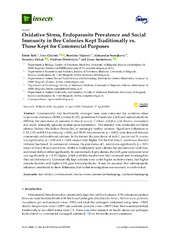Приказ основних података о документу
Oxidative Stress, Endoparasite Prevalence and Social Immunity in Bee Colonies Kept Traditionally vs. Those Kept for Commercial Purposes
| dc.creator | Tarić, Elmin | |
| dc.creator | Glavinić, Uroš | |
| dc.creator | Vejnović, Branislav | |
| dc.creator | Stanojković, Aleksandar | |
| dc.creator | Aleksić, Nevenka | |
| dc.creator | Dimitrijević, Vladimir | |
| dc.creator | Stanimirović, Zoran | |
| dc.date.accessioned | 2020-06-17T23:30:23Z | |
| dc.date.available | 2020-06-17T23:30:23Z | |
| dc.date.issued | 2020 | |
| dc.identifier.issn | 2075-4450 | |
| dc.identifier.uri | https://vet-erinar.vet.bg.ac.rs/handle/123456789/1838 | |
| dc.description.abstract | Commercially and traditionally managed bees were compared for oxidative stress (superoxide dismutase (SOD), catalase (CAT), glutathione S-transferase (GST) and malondialdehyde (MDA)), the prevalence of parasites (<i>Lotmaria passim</i>, <i>Crithidia mellificae</i> and <i>Nosema ceranae/apis</i>) and social immunity (glucose oxidase gene expression). The research was conducted on Pester plateau (Serbia—the Balkan Peninsula), on seemingly healthy colonies. Significant differences in CAT, GST and SOD activities (<i>p</i> < 0.01), and MDA concentrations (<i>p</i> < 0.002) were detected between commercial and traditional colonies. In the former, the prevalence of both <i>L. passim</i> and <i>N. ceranae</i> was significantly (<i>p</i> < 0.05 and <i>p</i> < 0.01, respectively) higher. For the first time, <i>L. passim</i> was detected in honey bee brood. In commercial colonies, the prevalence of <i>L. passim</i> was significantly (<i>p</i> < 0.01) lower in brood than in adult bees, whilst in traditionally kept colonies the prevalence in adult bees and brood did not differ significantly. In commercially kept colonies, the GOX gene expression level was significantly (<i>p</i> < 0.01) higher, which probably results from their increased need to strengthen their social immunity. Commercially kept colonies were under higher oxidative stress, had higher parasite burdens and higher GOX gene transcript levels. It may be assumed that anthropogenic influence contributed to these differences, but further investigations are necessary to confirm that. | en |
| dc.publisher | MDPI | |
| dc.relation | info:eu-repo/grantAgreement/MESTD/Integrated and Interdisciplinary Research (IIR or III)/46002/RS// | |
| dc.rights | openAccess | |
| dc.rights.uri | https://creativecommons.org/licenses/by/4.0/ | |
| dc.source | Insects | |
| dc.subject | Apis mellifera | |
| dc.subject | Lotmaria passim | |
| dc.subject | Nosema ceranae | |
| dc.subject | commercial beekeeping | |
| dc.subject | traditional beekeeping | |
| dc.title | Oxidative Stress, Endoparasite Prevalence and Social Immunity in Bee Colonies Kept Traditionally vs. Those Kept for Commercial Purposes | en |
| dc.type | article | |
| dc.rights.license | BY | |
| dcterms.abstract | Тарић, Елмин; Вејновић, Бранислав; Станојковић, Aлександар; Главинић, Урос; Станимировић, Зоран; Aлексић, Невенка; Димитријевић, Владимир; | |
| dc.citation.volume | 11 | |
| dc.citation.issue | 266 | |
| dc.citation.spage | 266 | |
| dc.citation.rank | M21 | |
| dc.identifier.wos | 000541085300015 | |
| dc.identifier.doi | 10.3390/insects11050266 | |
| dc.identifier.scopus | 2-s2.0-85085048464 | |
| dc.identifier.fulltext | https://vet-erinar.vet.bg.ac.rs/bitstream/id/4822/Oxidative_Stress_Endoparasite_pub_2020.pdf | |
| dc.type.version | publishedVersion |

